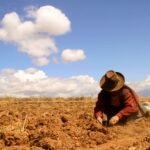Of the 20 million people who fell into poverty in Latin America, only 7 million have managed to escape their predicament
The latest figures from the BBVA Microfinance Foundation (BBVAMF)’s Research team estimate that extreme poverty in Latin America has increased in the last few years because of the pandemic and recently, as a result of the war in Ukraine and the state of the global economy, among other reasons. To such an extent that currently, of every 100 poor people, 42 are in extreme poverty, that is, they cannot cover their basic needs, including food.

As a result of COVID-19, 26 million people have lost their jobs. What is more, the hardest hit were also the most vulnerable and the most likely to fall back into poverty. Around 20 million people fell into poverty because of the pandemic and despite the subsequent recovery, according to the analysis carried out by BBVAMF, just under 7 million will have managed to cross this threshold by the end of 2022.
“In the next few years, we are moving towards a scenario with lower economic growth and less capacity among Latin American countries to drive fiscal policies to offset these impacts; that is bad news for those in poverty and for those who are on the brink”, indicates Giovanni di Placido, director for Analysis & Research at BBVAMF. “Nevertheless, the private sector and institutions such as the Foundation’s microfinance entities play a crucial role in the recovery and in the encouragement of inclusive growth.”

Peruvian farmer
The productivity of the over 3 million entrepreneurs served by the BBVAMF in five countries across Latin America (Colombia, Peru, Dominican Republic, Chile, and Panama) were affected by the pandemic, but 84% managed to recover to some extent. Today, many are once again negatively impacted by the region’s instability. Their income volatility has increased: 33% of clients who have had at least 5 loans with the institution have crossed the poverty line at least twice.
That is why the Foundation has prioritized and increased the support it provides its entrepreneurs, going beyond the strict definition of financial services. For example, it has expanded its financial education programs and, recently, the training it gives in digital skills to reinforce entrepreneurs’ businesses. As of today, it has trained 504,123 people.
An example of success are the clients who have digitalized their businesses, those who were able to transform them to make their income stream more secure. Specifically, in a pilot program conducted in Colombia, in collaboration with Trust for the Americas, 91% of entrepreneurs reported that their incomes had increased after completing the training in digital marketing and office skills. Furthermore, digitalization has shown that it can be a key factor in improving their efficiency, in opening up new markets, competitiveness and being able to deal with shocks. Growth in their surpluses has enabled one in three entrepreneurs on average, after two years banking with BBVAMF, to generate sufficient income to escape from poverty.
The private sector, committed to inclusive growth
BBVAMF and its five entities are not the only ones in the private sector who are committed to eradicating poverty and inequality. There is a significant consensus around the need to make whatever effort is required to drive a future with more inclusive and sustainable growth, which is pushing the agenda forward, not only in the public, but also in the private sector, in that direction.
To that end, Di Plácido points out that “companies have demonstrated this in their ESG (environmental, social, and governance) strategies, by bearing in mind that this is a lot more than box-ticking. It is a matter of differentiating themselves in their behavior to generate value and drive growth, while protecting the environment and our societies.”

Women in Puno, Peru
Impact investments will enjoy the greatest growth of all ESG strategies over the next 5 years. In the public sector, the sums involved are expected to rise from USD 123 billion in 2020 to nearly USD 700 billion by 2025. Likewise, in the private sector, growth in this investment area is forecast to expand from USD 180 billion currently to over 650 billion by 2025, according to BBVAMF data.
Di Plácido concludes that: “Although the current environment is challenging because of geopolitical conflicts, inflation and climate change, and experts are predicting a more somber scenario, the private sector’s commitment is a beacon on a difficult route that we have to take over the next few years in order, together, to eradicate poverty.”